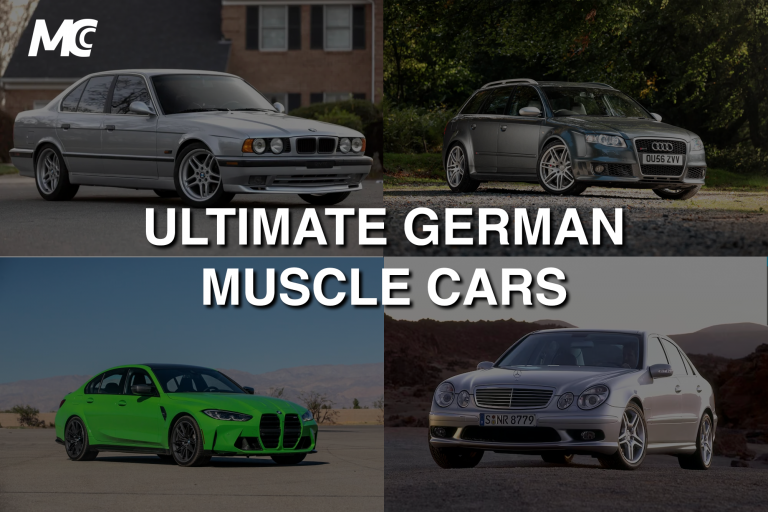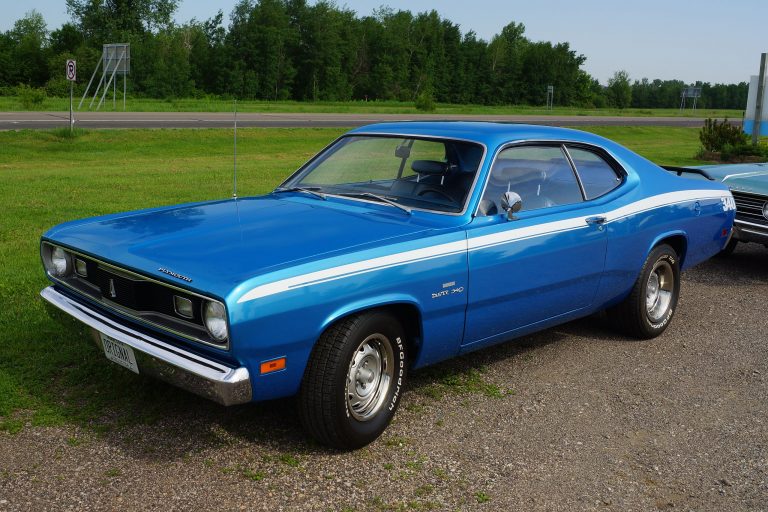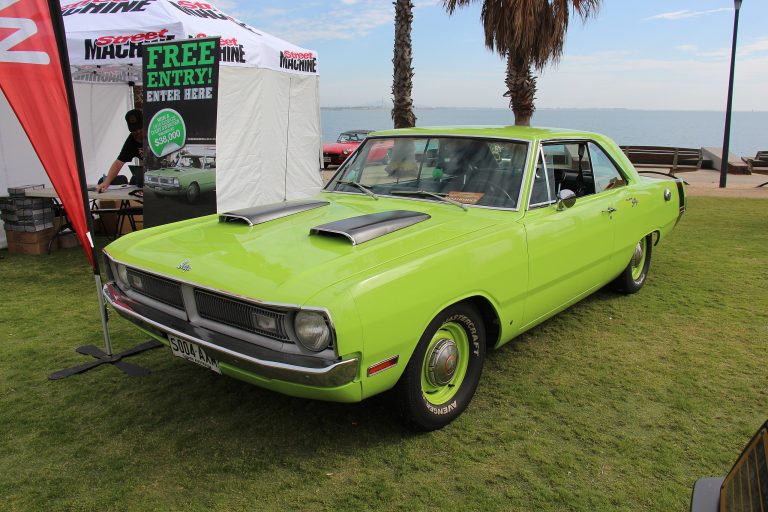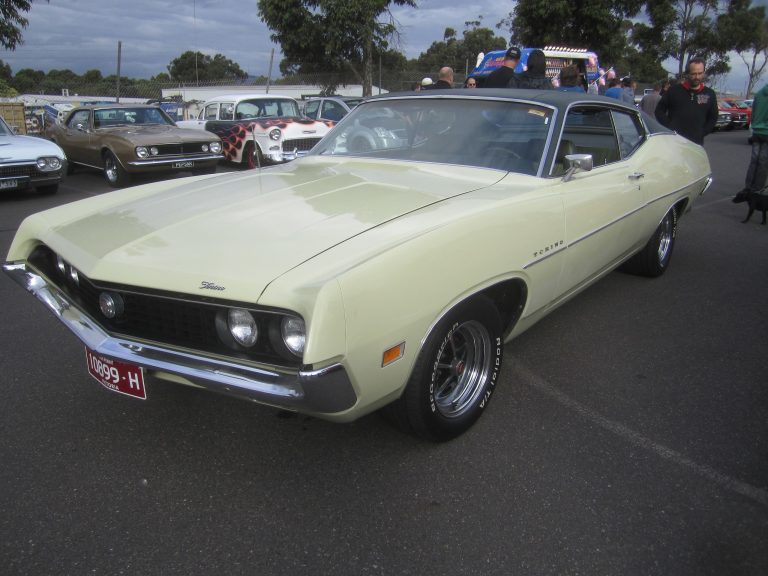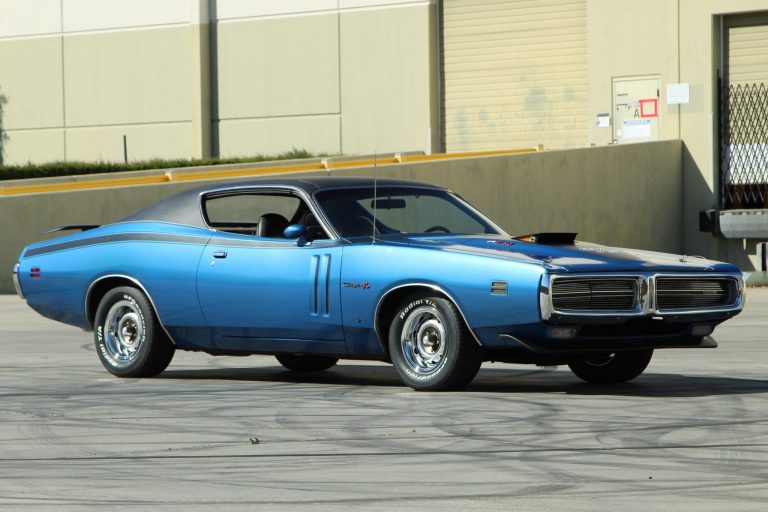Chevy El Camino
There is an unquestionable short list of unique American cars. That list would start with the Corvette and end with the Ford Raptor. Tucked somewhere near the top is the Chevrolet El Camino. The funny thing is that the Chevy El Camino wasn’t an American idea, despite it becoming a cultural icon. In fact, the El Camino is a bit of a fluke. A copy that got more popular than the original.
In the early 1930s, cars were only starting to become good and properly usable. At that time, cars were designed for an explicit purpose and typically only worked for that specific purpose. Cars were made for driving and trucks were meant for trucking. That changed in the mid-1930s, when Ford Australia built the first production “ute,” which combined the small form factor of a coupe with the read bed of a pickup truck. While Ford’s Utility Coupe is widely considered the first production ute, there were examples of the car/truck formula earlier than that, just not in full production.
The El Camino came much further down the line and was really just an attempt to encroach on the unique market that Ford had created with the Ranchero. It would be a while before the El Camino was a commercial success too, with the Ranchero outselling the El Camino by a significant margin until the El Camino’s second and third generations.
In this guide, we cover the famous El Camino, complete with all of its odd and charming characteristics. We’ll cover the El Camino’s specs throughout the years and its overall history which turned it into one of the most well-known American cars ever made.
Chevrolet El Camino History
In the 1930s, and far after that, Ford and Chevrolet were embroiled in a battle for supremacy in the American car market. Both manufacturers had very important and well-selling models at the time, including the Ford Model A and the Chevrolet AD Series Universal, and were trying to innovate to gain market dominance in new and unexplored areas. Ford revived their pre-war niche Australian ute creation and made it available for an American audience in 1957, which marked the first time that a mass-produced coupe utility vehicle was available in the U.S.
The Ranchero was built on a full-sized coupe station wagon platform that was later adapted to feature a truck bed. This would also be the formula used by the El Camino in the following years. The Ford Ranchero proved to be a massive hit and was popular with the automotive press and buyers alike. The Ranchero filled a niche that manufacturers thought existed but didn’t know for sure. Regardless, the Ranchero sold like hotcakes. As a result, GM jumped on the ute platform and immediately got to work on their own coupe utility vehicle.
The 1959 El Camino was the result of Chevrolet’s rushed response to the Ranchero. Like the latter, the El Camino was built on an existing Chevrolet station wagon chassis and converted to have a bed in the rear. The first-generation El Camino retained classic 1950s Chevrolet styling, including tailfins, which were a big selling point of the El Camino over the Ranchero. The El Camino wouldn’t be elevated to the truly legendary status that it enjoys today until later generations were released. Ultimately, the El Camino had more staying power than the Ford Ranchero, which ceased production eight years before the last El Camino rolled off of the assembly line.
First Generation Chevrolet El Camino (1959-1960)
With a brief history of the Chevy El Camino accounted for, let’s talk about the car/truck itself. The original 1959 El Camino was heavily based on the Chevrolet Brookwood station wagon which was one of the most significant full-sized models released the same year as the El Camino. With that being said, the styling of the coupe utility vehicle was extremely similar to the Chevy Bel Air. For a weird conglomeration of a coupe and pickup, the 1969 El Camino was a very attractive car. The 1969 model featured the same “cat’s eye” taillights as the Bel Air, as well as the Bel Air’s signature tailfins.
The Chevy El Camino was slightly longer and had a slightly larger bed than the competing Ford Ranchero, edging it out slightly in terms of practicality. In total, the first generation Chevy El Camino came with three engine options including one inline-6 and two V8s. Both the El Camino and the Ranchero had a similar payload capacity, somewhere around the 1,150 lb threshold. The first-generation El Camino also edged out the Ranchero in terms of handling, with full coil suspension on all four corners while the Ranchero used rear leaf springs. The El Camino was also touted as Chevy’s first pickup to use a metal bed floor instead of a wood one.
There were minimal changes to the El Camino for the 1960 model year. Other than small powertrain tweaks, the El Camino remained the same. Sales fell dramatically in 1960. Compared to the previous year with 22,246 sales, beating the Ranchero by 540 units, El Camino sales were nearly halved. Chevy pulled the plug on the El Camino as a result.
First Generation El Camino Specs
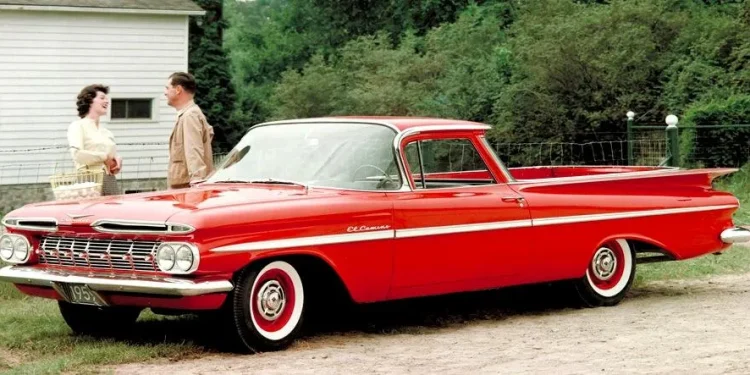
In total, the first-generation El Camino came with three engine variants, each with additional subvariants. The two V8 options, including a 283 Chevy small block and 348 Chevy big block, were the two premier engine options in the El Camino. There were, however, even more choices within those engine displacements. In terms of the 283-cid V8s, a 283-cid Turbo-Fire V8 with two- or four-barrel carburetion was offered. Additionally, there was a more advanced 283 Ramjet Fuel Injected V8 also available. The big-boy engine choice was the Chevy 348-cid V8 big block which was available in either four-barrel configuration or with a three-two carburetor setup.
For those that wanted a more modest engine arrangement that traded performance for fuel economy, a Chevy 235 I6 was also available in the 1959 and 1960 El Camino. There were three different transmission options for the first-generation El Camino including a 3 or 4-speed manual and a 2-speed Powerglide automatic.
Overall performance from the El Camino was impressive at the time. That is especially true for the 348 big block models. Hot Rod magazine took the first-gen, 348 V8, 4-speed El Camino to the drag strip in 1959. The real-world test produced a 0-60 time of 7 seconds and a 14-second/100-mph quarter-mile performance.
1959 Chevrolet El Camino
The El Camino debuted in 1959 based on the Impala platform to compete with Ford’s Ranchero. The name meant “The Road” in Spannish, and Chevrolet stressed its car like platform and styling, which was combined with the functionality of a truck bed. The El Camino was based on the Impala, and shared the Impala’s wild styling, including its trademark “cat’s eyes” taillights and wings. The front end was all Impala, as was most of the interior trim.
Production: 22,246
1960 Chevrolet El Camino
The El Camino underwent an extensive restyling in its second year, which mirrored the changes to the Impala. The wings and taillights were toned down a bit (though still pretty wild) and the body lines were a bit more angular. Despite the relative success of the El Camino, Chevrolet ceased production after 1960. It would reappear four years later on the new Chevelle platform.
Production: 14,163
Second Generation Chevy El Camino (1964-1967)

After a four-year hiatus, the El Camino was reintroduced to the Chevrolet lineup in 1964. Chevrolet decided to dramatically change up the El Camino formula for the second generation. It was built on a completely different chassis and with a slightly different market in mind.
The 1964-1967 Chevy El Camino was built on the Chevy Chevelle platform. Chevy thought that it was smart to build off of one of the brand’s most successful mid-size models. Due to the fact that the El Camino switched to a smaller A-Body platform, it was significantly shorter than the previous generation. While it was stouter than the 1959-1960 bodystyle, the second generation El Camino was just as, if not more, practical.
While the Chevy El Camino embraced the practicality angle with open arms, the unique styling that helped the first-generation El Camino sell so well was also lost. Gone were the wild tailfins and ornate taillights. The second-gen El Camino was nearly identical to the first-generation Chevelle, which was designed to be a practical family car.
Another dissuading factor for the power fanatics out there at the time, the second-generation El Camino wasn’t initially offered with the powerful V8 engine options that the Chevelle received. Additional engine options would be added to the El Camino lineup throughout the second generation’s build cycle. Initially, there were two inline-six engines and multiple different V8 engines of different displacements. Transmission options consisted of a three-speed manual, 4-speed manual, and 2-speed Powerglide automatic transmission.
The second-generation El Camino received aesthetic updates as the Chevelle did. Between 1964 and 1968, the El Camino received three visual facelifts that introduced a slightly more aggressive facade. By 1968, the El Camino has some potent V8 engine options including a 350 horsepower 327 L79 and Chevy L35 V8 which produced 325 horsepower.
Second Generation El Camino Specs
Compared to the first-generation El Camino which had a pretty limited number of drivetrain arrangements, the second generation featured quite a few engine options. Upon release in 1964, the engine options were limited to two inline-6 engines, including the 194-cid I6 and-cid 230 I6, as well as a base 283-cid V8 and 327 small-block V8. The 194 and 230-cid inline-6 options were meant for those that wanted the practicality of the El Camino without the V8 fuel consumption. They produced 120 and 155 horsepower respectively.
The initial V8 El Camino engine options were also somewhat underwhelming. Counter to its name, the standard 2-barrel 283 “Turbo-Fire” V8 only produced 195 horsepower. There was an optional 4-barrel carb 283 V8 also available that produced a slightly more impressive 220 horsepower. In 1965, an additional high-performance 327 V8 was also added to the El Camino build sheet. The 250-300 horsepower 327 V8 was also used in the 1965 Chevelle SS.
Starting in 1966, the El Camino finally received a big block V8 engine option. The 396-cid V8 found in the Chevelle SS 396. Ultimately, there were three 396-cid V8 engines available for order in the El Camino including the L35, L34, and L78. The engines ranged in power from 325-375 horsepower. They mainly differed in terms of compression, head design, and other subtle but significant differences.
1965 Chevrolet El Camino
The El Camino got a true boost of performance with the addition of two powerful 327 engine options. For a mere $140 extra, the buyer could trade the 250 bhp 327 for a 300 bhp version. An extra $200 go you the 350 bhp version.
Production:
Engines: 283 V8 195bp. 283 V8 220bhp. 327 V8 250bhp. 327 V8 300bhp. L79 327 V8 350bhp.
1966 Chevrolet El Camino
The 1966 El Camino saw the introduction of the mighty 396 engines, with either a 325 bhp or 350 bhp version available. The 375 bhp version available in the Chevelle was, sadly, unavailable in the El Camino. Standard equipment on all El Camino’s included specially calibrated high rate springs and double acting shocks at each wheel. The interior was all vinyl and bucket seats, and special consoles were available. The Synchro-Mesh three-speed transmission was standard, but a four-speed wide or close ratio transmission or the two-speed Powerglide automatic transmission could be ordered.
Production: 35,119
Engines: 396 V8 325bp@4800rpm, 410lb-ft@3200rpm. L34 396 V8 350bhp@5200rpm, 415lb-ft@3600.
1967 Chevrolet El Camino
The 1967 El Camino received a few changes: a new grille, a new front bumper, and the side trim was moved up the side panels from the lower body molding. The tailgate was now trimmed with an attractive vinyl, wood-grained strip and new taillights. A vinyl roof was now available as an option. Interiors were all vinyl, and the Custom trim had more trim detail and textured vinyl seats. Air-adjustable shock absorbers were introduced on the El Camino; they could be inflated or deflated to provide proper support depending on the load. The performance suspension was required for El Camino’s equipped with the 396 engine.
Production: 34,830
Engines: 396 V8 325bp@4800rpm, 410lb-ft@3200rpm. L34 396 V8 350bhp@5200rpm, 415lb-ft@3600.
Third Generation El Camino (1968-1972)
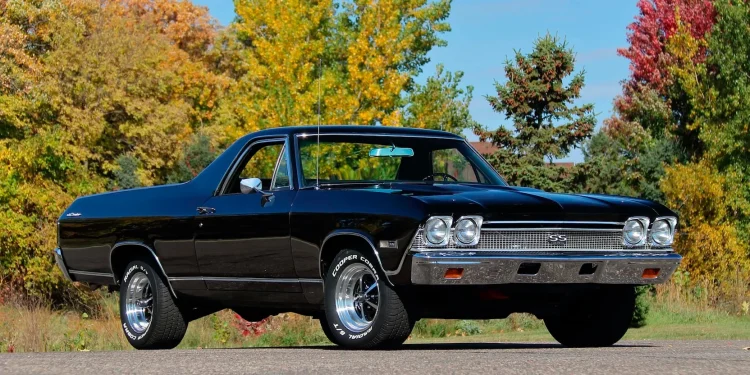
By the time that the third generation El Camino was released, Chevrolet was beginning to realize that many people would sacrifice added utility for more power. In the earlier stages of the third gen’s build cycle, Chevrolet was a dominant force in the muscle car era. Cars like the Chevy Chevelle SS and Chevy Nova SS were selling due to the power of their massive engines. So, Chevy did the same with the El Camino in the late 1960s.
The third-generation El Camino received another chassis change, then built on the longer Chevelle wagon chassis. The wheelbase of the El Camino was increased by an inch. The car itself also grew by a couple of inches. Other than that change, the El Camino closely followed the changes made to the Chevelle as far as external and internal updates were concerned. Disc brakes became optional for the first time on the third-gen El Camino. The interior was also updated to include cloth and vinyl seats and new flooring.
1968 was the only year in the El Camino’s lifecycle that there was a dedicated El Camino SS396 option available. The SS came with three engine options ranging from 325 horsepower to 375 horsepower. Other El Camino Super Sport models were released in the following years. Some featured other potent 396, 402, and 454-cid V8 engine options, but 1968 was the only year that the Camino received its own SS396 designation.
1970 would be the last year of the truly potent third-generation El Caminos, as the government put restrictions on emissions and engine compression while also implementing new power rating guidelines. Over the third gen’s build cycle, it received notable facelifts in 1970 and 1971.
Third-Generation El Camino Specs
The third-generation El Camino retained just as many engine options as the generation prior. With that being said, there were some notable changes to the engine options. The two inline-6 engines received more displacement, bumping them up to 230 and 250-cid respectively. Despite the added displacement, the engines’ horsepower ratings decreased.
There were three Chevy small block V8 engine options, including the 307 V8, 327 V8, and the 350 V8. Chevy big block V8 engine options included multiple versions of the 396 V8. These included the Turbo-Jet 396 in multiple carburetor configurations, and the 375 horsepower L78 big-block. These engine options could be ordered in the SS-396 El Camino which was only available for that year.
1970 El Caminos were available with an updated 402-cid V8. Despite being a larger displacement engine, Chevy still marketed the 402 V8 as a 396. That was reflected by the use of 396 badges on those models. While the official number of units built is not known, there were some 1970 Chevy El Caminos that received the biggest and baddest Chevy engine at the time: the LS6 454 V8. The LS6 V8 pumped out a whopping 450 horsepower and 500 lb-ft of torque.
The same engine options remained for 1971 and 1972 despite receiving a massive horsepower decrease due to tightening emissions guidelines and new power rating regulations. By 1972, the Chevy inline-6 El Caminos only made as much as 110 horsepower. The small blocks only made 175 horsepower.
1968 Chevrolet El Camino SS
The 1968 El Camino received the same changes as the Chevelle and was now based on the 116 inch wheelbase platform used by the Chevelle sedan and wagon. The SS396 debuted as a new model of the El Camino and, just like in the Chevelle, came only with one of the 396 V8s. The new El Camino featured a longer hood, “vee” rear side windows, a recessed rear window (like the Chevelle) and a rakish front end. The tailgate of the SS models had a narrow band of black that framed the SS396 emblem. The front fenders also sported the new “396” emblem.
Simulated twin-domed hood scoops were included with louvered ports located at the rear edge of the hood. The grille was accented in black and featured the 396 emblem. All SS also featured standard six inch wheels with red line tires. The standard engine in the SS396 remained the 325 bhp 396 engine. The 350bhp version was still available and finally the 375bhp was available for the first time.
Production: El Camino: 41,791 (SS396: 5,190)
Engines: 396 V8 325bp@4800rpm, 410lb-ft@3200rpm. L34 396 V8 350bhp@5200rpm, 415lb-ft@3600. L78 396 V8 375bhp@5600rpm, 415lb-ft@3600rpm.
1970 Chevrolet El Camino SS
The 1970 El Camino received the same changes as the Chevelle including a new more blunted Vee front end and a new grille, which was black-accented on the SS. The El Camino was still available in either Base or Custom trims, but now the SS option was only available on the Custom trim. The Custom Pickup had bright trim, which ran from the front to rear bumper about a quarter of the way up the side. The wheel wells also sported bright trim. The popular cowl induction hood was also optional on the SS.
The SS option included special patern and custom vinyl seat trim, sport mirrors, striping, and badges, 15×7 Rally rims, fat RWL tires, SS emblems, black out grille, and a choice of three of the four high-performance 402 cid V8 engines. Interestingly, although the 396 engines now displaced 402 cubic inches, they were either called “396” or “Turbo-Jet.” But the key for performance buyers was the introduction of the new corporate 454 engines, the LS5 rated at 360 bhp and the mighty 450 bhp LS6. The 454 engines came only with the Turbo-Hydramatic or a close-ratio four-speed manual transmission.
Production: 47,707
Engines: 350 V8 300 bhp. L34 402 V8 350bhp@5200rpm, 415lb-ft@3400. 402 V8 375bhp@5600rpm, 415lb-ft@3600rpm. LS5 454 V8 360bhp@5400rpm, 500lb-ft@3200rpm. LS6 454 V8 450bhp@5600rpm, 500lb-ft@3600rpm.
Performance: LS6/454: 1/4 mile in 13.44 seconds @ 108.17 mph.
1971 Chevrolet El Camino SS
1971 was not immune from the general collapse of muscle car performance. In response to GM’s edict that all engines ran on unleaded fuel and to meet ever-restrictive emission standards, Chevrolet detuned all its engines which resulted in large drops in engine output. The 402 engine that was previously still known as a 396 was renamed the “Turbo Jet 400” and offered only 300bhp, down from 3500bhp. The 375bhp version was no longer available. The LS6 454 was also killed, but the LS5 454 returned with 365bhp, an increase of 5bhp from 1970. All El Caminos got the new single headlight design from the Monte Carlo and could be optioned with hood stripes and the cowl induction hood.
The SS package was again only available on the Custom Pickup and included a special instrumentation panel with a black steering wheel and column and an “SS” hub emblem. It also included 15×7 inch sport wheels, F60x15 white-lettered bias ply tires, a sports-type remote control outside body colored rearview mirror, power disc brakes, and high output battery. Interestingly, only the LS5 carried external engine ID; they carried “SS 454” badges. All others only said “SS.” That was a pretty revealing sign of the times. As part of GM’s brand dilution strategy, GMC offered an identical version of the El Camino that they called the “Sprint” with an “SP” option that mirrored the SS package.
Production: 41,606
Engines: L65 350 V8 245bhp@4800rpm, 250lb-ft@2800rpm. L48 350 V8 270bhp@5600rpm, 360lb-ft@3200rpm. LS3 402 V8 300bhp@4800rpm, 400lb-ft@3200. LS5 454 V8 365bhp@4800rpm, 465lb-ft@3200rpm
Fourth Generation El Camino (1973-1977)
The fourth-generation El Camino represented a significant shift in automobile design and overall philosophy caused by stricter regulations and safety requirements. Overall, the El Camino, and most other cars of the time, got heavier, larger, and less powerful due to the need to install safety equipment and compensate for rising gas prices.
Like the El Camino generation prior to it, the fourth generation was built on the Chevelle A-Body platform. However, unlike previous generations that were based on four-door versions of the Chevelle sedan, the fourth generation was built on the Chevelle wagon chassis. That made it the biggest El Camino to date.
The fourth-gen El Camino also introduced some pretty important handling and quality-of-life improvements as well. For example, the coil spring suspension received an update with revised and more balanced spring rates. Disk brakes were standard on the El Camino from 1973 onwards. Freeway stability was also dramatically improved thanks to camber adjustments. Other than that, the fourth-gen also received a better internal ventilation system, more thermally efficient windows, and frameless driver and passenger side windows. Visibility was also increased thanks to redesigned slim A-pillars.
Between 1973 and 1977, the El Camino received numerous revisions and aesthetic facelifts. Most of them were rather minor, with the grille and headlights being the primary points of change. There were multiple trim options available for the fourth-gen including the El Camino Classic, Estate, and El Camino SS.
Fourth Generation El Camino Specs
The fourth-generation Chevy El Camino dropped the 230-cid Chevy inline-6 engine, leaving only the 250-cid I6 left. In addition to the single inline-6 engine, the fourth-gen also came with the option of two Chevy small-block V8 engines and two Chevy big-block V8 engine options. The 307-cid V8 carried over from the previous generation. It remained the base engine for the 1973-1974 fourth-gen. The 350 V8 engine became the base after 1974. Additionally, a 350 small block was offered with either a 2-barrel or 4-barrel carb arrangement. There was a significant power discrepancy between them, with the 2-barrel producing 145 horsepower and the 4-barrel pumping out 175 horsepower.
As for the two Chevy big-block engine options, the fourth-gen El Camino could be ordered with either a Chevy 454 big-block V8 or a 400-cid big-block V8 after 1974. The Chevy 454 big-block was obviously the top dog as far as El Camino engine options were concerned. It was placed in the El Camino SS. Overall, the engine options continued to be downrated through 1977. The 250 I6 was only rated at 105 horsepower, the 305-cid V8 at 140 horsepower, the 400-cid at 175 horsepower, and the 454 at 215 horsepower.
Fifth Generation Chevy El Camino (1978-1987)
1978 marked a big shift for the El Camino, as the styling and chassis were changed dramatically. Unlike the previous generations, the fifth-generation El Camino’s styling was based on the Chevrolet Malibu instead of the Chevelle. Its wheelbase was longer than the previous generation by an inch. The fifth generation was also the first El Camino to have a bespoke chassis, not shared with another Chevy model. The new design was much more angular than the previous generation and featured square headlights as opposed to rectangular ones.
Between 1978 and 1982, the El Camino didn’t receive many changes aesthetically or in terms of chassis dynamics. Most of the changes occurred under the hood. The El Camino received its final facelift in 1982, sporting a mesh grille and four headlights. Once again, most of the changes made to the El Camino before its discontinuation in 1987 were engine related. Chevy diesel V8 engines were added to the El Camino lineup in 1982, leaving only the Chevy 5.0L V8 as the only petrol V8 engine option for the El Camino.
Fifth Generation Chevy El Camino Specs
The fifth-generation El Camino came with a startling amount of engine options. Some might even say too many. The base engine was again downgraded and downsized to a 200-cid V6 engine, producing only 95 horsepower. There was also a 231-cid Buick V6 on offer for those in California, where the Chevy 200-cid V6 had trouble passing emissions. The only two V8 options included the Chevy 305 small-block and Chevy 350 small-block. They only put out 145 horsepower and 170 horsepower respectively. 1978 introduces a 267 small-block as a middle engine option. The base V6 received a displacement increase to 229-cid in 1981, producing 110 horsepower.
Following the 1982 El Camino facelift, Chevy revamped the engine options again. A 305 diesel V8 made its way onto the El Camino build list, producing a meager 105 horsepower. The 267 small-block V8 was removed from the lineup in 1983, leaving only the 305 Chevy small-block as the last gas-powered V8 standing.


